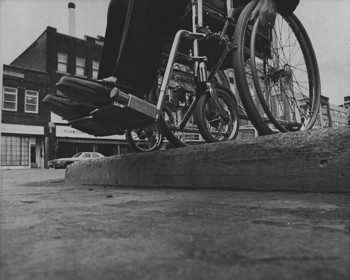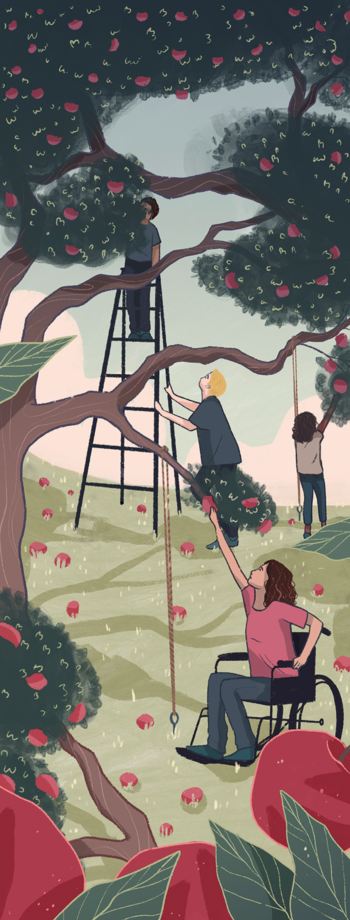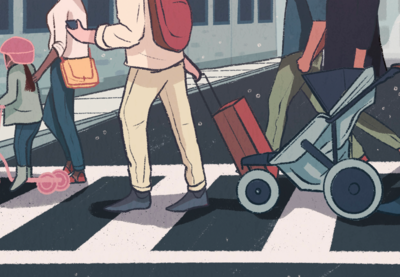In Octavia Butler’s iconic science fiction novel Parable of the Sower, protagonist Lauren Olamina reimagines community. Facing violence, government instability, social stratification and widespread suffering, she preaches adaptation; she envisions how, in the right setting, meeting people’s needs could help communities grow “into something brand new.”
“Now,” she says, “is a time for building foundations.”
During a dystopian school year in which everyone was forced to adapt amid a pandemic, political upheaval and social isolation—and the ongoing traumas of racial injustice and violence—Butler’s words felt prescient.
“One of the purposes of science fiction is to expand our conception of what’s possible,” explains Dr. Ashley Woodson, director of the Abolitionist Teaching Network’s Virtual Freedom School. “And we all just lived through science fiction.”
The 2020-21 school year demanded something brand new—shaped by the needs of students, families and educators facing unprecedented challenges. In this crisis, existing inequities grew worse. They required targeted solutions and a reimagining of the status quo.
The best solutions were designed to help students and families least supported by the system. And those solutions proved widely beneficial. Universal meal programs designed to ensure food reached families experiencing homelessness and poverty also granted greater access to families who traditionally fall just outside of outdated free meal qualifications. Districts that suspended standard homework and grade models helped students who had to work or care for siblings and those experiencing mental health struggles. Schools that emphasized outreach to families who may not have access to public aid or home language resources—such as undocumented families—improved overall family engagement and communication.
These targeted solutions with broad benefits illustrate what many advocates call a “curb-cut effect”—a phenomenon rooted in decades of activism that has newfound relevance in the ongoing fight to center equity in our schools.
When the nation targets support where it is needed most—when we create the circumstances that allow those who have been left behind to participate and contribute fully—everyone wins.
— Angela Glover Blackwell

What Is the Curb-cut Effect?
Today, curb cuts are ubiquitous points of access required by U.S. law. But these ramps connecting sidewalks to streets were hard-won.
Disability activist Patrick William Connally, describing his digital painting depicting the first curb cut in Berkeley, California, explained that its purpose was to help people in wheelchairs. The fight for curb cuts was championed by and for people with disabilities. But its effects were broader.
“People without wheelchairs began using the ramps too,” Connally reflected. “In fact, sidewalk ramps made our public spaces more livable for everyone.”
People pushing strollers and luggage moved more easily through the city. So did skateboarders and elderly people. A targeted solution that granted better access to wheelchair users had incidental benefits for people across the Berkeley community and across the country.
That “curb-cut effect” has its roots in disability activism, but the concept—like curb cuts themselves—has proven widely applicable.
In a highly cited 2017 article in the Stanford Social Innovation Review, lawyer, activist and policy expert Angela Glover Blackwell highlights the curb-cut effect as a framework for understanding the community-wide benefits of any innovation specifically designed to achieve equity for an underserved group.
“There’s an ingrained societal suspicion that intentionally supporting one group hurts another. That equity is a zero-sum game,” writes Blackwell. “In fact, when the nation targets support where it is needed most—when we create the circumstances that allow those who have been left behind to participate and contribute fully—everyone wins.”
Blackwell reframes the curb-cut effect as a way of describing the outsized benefits of equity-based solutions. Access for those denied it is the goal. Access for everyone is the result.

Blackwell foregrounds the understanding that a policy must be explicitly designed to give a specific group of people what they need to thrive. This is what Blackwell calls curb-cut thinking. It’s an informed faith in equity, which she defines as “creating the conditions in which everyone can participate, prosper, and reach full potential.”
She offers simple examples. Seat belt legislation designed to protect kids saved countless adults’ lives. Bike lanes designed to protect riders improved pedestrians’ safety. Public transit routes designed to give underserved communities access to economic opportunity benefited those economic centers.
This foundational framing of the curb-cut effect confronts the idea that equality (everyone is treated the same) is more beneficial than equity (everyone gets what they need).
“Equality gives everyone the right to ride on the bus,” Blackwell wrote. “Equity ensures that there are curb cuts so people in wheelchairs can get to the bus stop and lifts so they can get on the bus and ensures that there are bus lines where people need them so they can get where they need to go.”
For educators, understanding curb-cut thinking and the curb-cut effect offers a deeper understanding of what it means to advocate for transformational change and equity.
The Curb-cut Case for Centering Equity in Schools
“We need to be centered on where the lack of equity is and the lack of protections are,” says De Palazzo, the Safe & Healthy Schools Director at Equality Florida. “At the same time, we also know to frame it broadly. That’s strategy, but it’s also truth.”
Both Palazzo and Woodson say an understanding of the curb-cut effect can be useful in an advocate’s toolkit. Providing examples of how equity-centered policies or actions have improved or could improve the lives of many students and the community broadly can help school and community leaders see the measurable and intangible benefits of equity.
“This is a particular type of argument,” Woodson says, “but it is a useful way of thinking about it in order to pitch reform. … It’s one strategy of many strategies where we can begin to mitigate the harm that schooling causes for all kids, particularly for Black kids.”
For advocates of more equitable schools, the first step of curb-cut thinking is to uplift students and families least supported by any given policy or system.
Palazzo has spent years in coalitions fighting for LGBTQ students’ rights and protections in Florida school districts. As those students face threats of anti-trans legislation, Palazzo points to curb-cut effects for previously hard-won rights.
She mentions single-stall restrooms—a targeted solution to provide gender nonconforming and nonbinary youth with an option (not a mandate) to use a private restroom space where they feel safe. Having this option in schools proved beneficial for many students—including those with disabilities and social anxiety or those experiencing bullying and violence.
Curb-cut thinking will lead to widespread benefit, but that isn’t the goal. The goal is equity for those being denied equity.
Centering LGBTQ students, Palazzo has found, creates more inclusive learning environments for many students. But specificity matters. Naming LGBTQ identities in anti-bullying policies creates both a safer school climate and a precedent that is difficult to undo.
Such policies can always be referenced when schools try to scale back or discriminate—and they are harder to dismantle than vague, equality-focused policies that relegate some vulnerable students to the margins.
“What’s critical is having it framed within [a group of underserved students’] particular areas of interest and need, and how it speaks directly to them,” Palazzo says. She sees the curb-cut effect as a tool for illustrating that such policies work for the entire school community.
Curb-cut thinking, advocates say, can inform equity-centered innovations across a school.
For Woodson, that includes advocating for the expansion and improvement of Black history education in K-12 schools. Against the backdrop of concerted efforts to curtail U.S. history curricula that honestly reckon with racism and uplift the contributions of Black people, Woodson sees an opportunity to advocate for its widespread benefits.
“When we refuse to acknowledge the intellectual diversity within the Black freedom struggle,” Woodson says, “we limit our imagination of what reparative work might look like, not only for Black people but for all who have been marginalized, exploited or subjected to state violence or extralegal violence.”
Woodson says everyone’s understanding suffers when Black history is erased or simplified. That’s why she also says it’s important for educators and advocates to understand that there is often an equal and opposite version of the curb-cut effect: Policies that don’t center equity or those least supported do immense harm to students experiencing discrimination or erasure and also do secondary harm to their peers.
“It’s recognizing that when you don’t think in that way, what we end up with hurts students,” Woodson says.
Woodson points to “gifted and talented” programs as an example. These programs’ “neutral” models have historically ignored the role of bias in selection and evaluation. This exacerbates opportunity gaps between white students and students of color and ultimately fails to deliver meaningful advancements in literacy or math skills for all kids.

In Palazzo’s work, both erasure and targeted discrimination can produce this widespread harm. An anti-bullying policy that fails to protect specific identities ultimately isn’t enforced; the lack of guidance leaves educators unsure how, if and when to address identity-based harassment and leaves students unsure of their rights to safety. And something like an anti-trans sports bill requiring girl athletes to undergo medical examinations if their gender identity is challenged harms and invades the privacy of trans girls, as well as intersex students and cisgender girls accused of having “masculine” features.
In light of the COVID-19 pandemic, it’s clear that a focus on equity could move schools toward repairing historic harms and transforming the system to better serve students and families historically harmed by school spaces.
Woodson says the pandemic proved the viability of many targeted policies that were once deemed too difficult. Access to the internet and digital devices increased for many students who didn’t have them at home. Free breakfast and lunch programs expanded, including during vacation times that historically burdened struggling families. Schools provided alternative methods for students to engage with classwork and the school community. More leaders questioned standardized testing and the effects of economic and social conditions on the results. The efficacy and inequity of homework came under question.
“There’s no reason that we would go back to normal and reconstruct the barriers,” Woodson says. “I think all children benefit from these novel ways of thinking about what schooling could be.”
Nationwide, schools face major challenges to equity-centered work. There are targeted campaigns to depict everything from inclusive curricula to anti-discrimination policies as exclusionary. The reality of the curb-cut effect exposes these false narratives and provides a framework with which advocates can fight for equity-focused policies.
And as Woodson notes, there are tremendous opportunities to learn from creative solutions that arose from an education system in crisis. It’s a time for building foundations. Even against the backdrop of struggle, something brand new seems possible.
Remembering the Purpose
Despite its value as a tool for understanding and discussing the benefits of equity-based approaches, advocates warn against using the curb-cut effect as a primary justification for equitable policies.
Woodson and Palazzo both stress that universal benefit cannot be the goal—and that an overemphasis on the widespread benefits of equity policies could, in practice, erase the most pressing needs of underserved students.
“We absolutely still have to have a pointed method of speaking directly to the needs of any group that is marginalized,” Palazzo says. “We cannot completely water it down.”
“Because of resource and opportunity hoarding,” Woodson explains, “if you implement a policy that makes it even a little better for the folks who already have power, that’s how it will continue to compound itself exponentially.”
As Woodson puts it, “Black kids have to be enough.”
It’s a point Blackwell herself makes. Curb-cut thinking will lead to widespread benefit, she contends, but that isn’t the goal. The goal is equity for those being denied equity. The goal is opportunity for those being denied opportunity. The goal is access—a ramp where a barrier once stood.
By most accounts, the first curb cuts in the United States appeared in 1945, in the Michigan towns of Battle Creek and Kalamazoo. Jack H. Fisher—a lawyer who left the Army after a stateside leg injury—advocated for World War II veterans with disabilities, including through a campaign that led to curb cuts and safety rails.
Nearly three decades later, in Berkeley, California, a literally groundbreaking movement took place. Berkeley’s Independent Living Movement, spearheaded by college students and disability activists like Ed Roberts, pushed for safer, more accessible sidewalks. A group of these activists, who called themselves the “Rolling Quads,” went out at night, mixing and pouring concrete to create makeshift ramps on street corners. By 1972, their advocacy and crude construction pressured the city of Berkeley into creating its first official curb cut.
When those activists poured concrete over Berkeley’s curbsides, they weren’t thinking of the bike riders or delivery drivers who would find easier passage. They were confronting a system that had excluded them from the beginning. They were demanding access and entry for wheelchair users and people with disabilities—for themselves.
They were creating the conditions that allowed them to transform a space built by and for someone else into something brand new.

